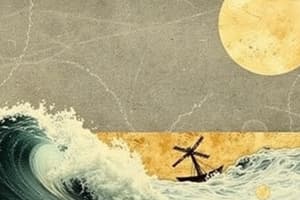Podcast
Questions and Answers
Match the type of earthquake with its corresponding cause:
Match the type of earthquake with its corresponding cause:
Tectonic Earthquake = Geological pressures on rocks and adjoining plates Volcanic Earthquake = Volcanic activity Explosion Earthquake = Chemical or nuclear device explosion Collapse Earthquake = Caverns or mine collapses underground
Match the location where aftershocks may occur with their description:
Match the location where aftershocks may occur with their description:
Same fault as main shock = Regions ruptured in the main shock Different fault from main shock = Regions not ruptured in the main shock Residual stress release = Explanation for aftershocks occurring in different regions Physical and chemical changes in rocks = Tectonic earthquake occurrence
Match the earthquake prospecting method with its description:
Match the earthquake prospecting method with its description:
Prospecting = Field search for mineral deposits Seismic Prospecting = Conducted on land or at sea Mineral deposit search objective = Economic development through mining operations Seismic waves utilized for exploration = Seismic prospecting method
Match the Earth's layer with its composition:
Match the Earth's layer with its composition:
Match the geological evidence with the concept it supports:
Match the geological evidence with the concept it supports:
Match the scientific process with its outcome:
Match the scientific process with its outcome:
Match the term with its definition:
Match the term with its definition:
Match the following geological processes with their impacts on landscapes:
Match the following geological processes with their impacts on landscapes:
Match the following fault types with their descriptions:
Match the following fault types with their descriptions:
Match the following Earth's outermost layer movements with their consequences:
Match the following Earth's outermost layer movements with their consequences:
Match the following terms related to ocean engineering with their functions:
Match the following terms related to ocean engineering with their functions:
Match the following geological phenomena with their definitions:
Match the following geological phenomena with their definitions:
Match the following earthquake terms with their explanations:
Match the following earthquake terms with their explanations:
Study Notes
Ocean Engineering and Geology
- Ocean engineering is crucial in preserving coastal structures from erosion, developing energy sources, and protecting ports and harbors.
- Engineers design ships and offshore structures to withstand challenging sea environments, considering factors like waves, currents, and storm surges.
Rivers, Wind, and Sea
- Rivers erode, transport, and deposit sediments, influencing the formation of landscapes.
- Wind erosion shapes landforms and transports particles.
- The sea contributes to coastal erosion and sedimentation.
Earthquakes
- An earthquake is an intense shaking of Earth's surface caused by movements in Earth's outermost layer.
- Faults are fractures in rocks caused by stress or the push-pull on the crust that causes the rocks to twist or tear apart.
Types of Faults
- Normal faults: the block above the fault moves down relative to the block below the fault.
- Reverse faults: the block above the fault moves up relative to the block below the fault.
- Thrust faults: the movement of blocks along a fault is horizontal.
Earth's Core
- The Earth's core is a dense metallic core at the planet's center.
- The Earth has a magnetic field because of its core.
- The inner core is solid, composed mainly of iron and nickel, due to high temperatures.
- The outer core is primarily composed of liquid iron and nickel, and its movement generates the Earth's magnetic field through the geodynamo process.
Continental Drift and Plate Tectonics
- Continental drift describes the movement of continents over time.
- Three main evidences for continental drift are:
- Geologic: the east coast of South America and the west coast of Africa seem to fit together like pieces of a jigsaw puzzle.
- Identical rocks: identical rocks, of the same type and age, are found on both sides of the Atlantic Ocean.
- Fossils: evidence in the places certain fossils are found.
Types of Earthquakes
- Tectonic earthquakes: occur when rocks and adjoining plates are subjected to geological pressures that result in physical and chemical changes.
- Volcanic earthquakes: occur in conjunction with volcanic activity.
- Explosion earthquakes: occur as a result of a chemical or nuclear device explosion.
- Collapse earthquakes: smaller-scale earthquakes brought on by caverns or mine collapses underground.
Seismic Prospecting
- Seismic prospecting is the field search for mineral deposits, usually with the ultimate objective of economic development by mining operations.
- Seismic prospecting can be conducted either on land or at sea.
Studying That Suits You
Use AI to generate personalized quizzes and flashcards to suit your learning preferences.
Description
Test your knowledge on ocean engineering and its importance in preserving coastal structures, developing energy sources, and protecting ports and harbors. Explore how engineers design ships and offshore structures to withstand challenging sea environments. Gain insights into the critical role of geology in designing resilient coastal infrastructure.




